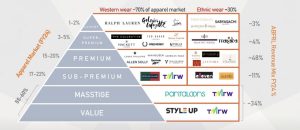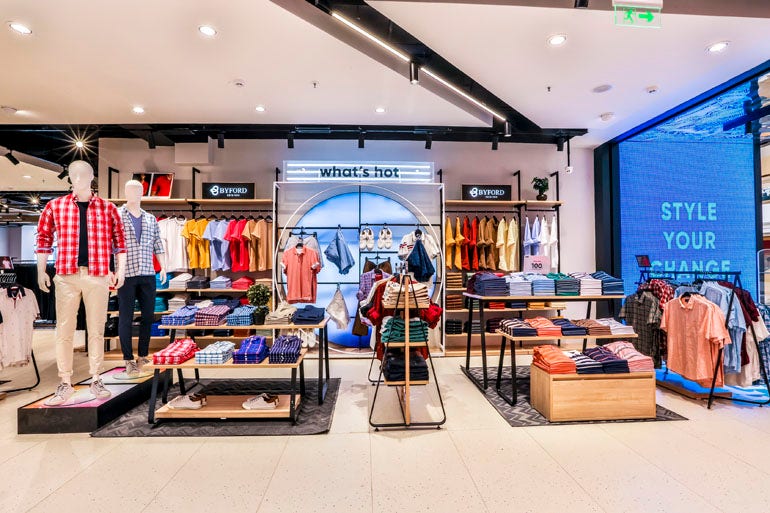Executive Summary
India’s apparel market is in the midst of a multi‑year formalization and premiumization cycle. At roughly USD 100–110 billion in FY24 and poised to approach USD 180–200 billion by FY30, the category is expanding on the back of rising disposable incomes, continued urbanization, widening digital access, and increasing exposure to global fashion cues. The structure of demand is bifurcated: everyday, office, and casual needs pull consumers toward Western wear, while weddings and festivals preserve a sizable ethnic core. This twin engine underpins the market’s resilience and its breadth of opportunities. Independent industry work estimates that Western wear accounts for ~70% of sales and ethnic ~30%, a split that has remained stable even as digital penetration rises and formalization accelerates.
Within this context, Aditya Birla Fashion and Retail Limited (ABFRL) stands out for deliberately architecting a portfolio that mirrors the Indian consumer pyramid.

At the top, licensed international brands and partnerships (for example, Ralph Lauren) and Indian couture (Sabyasachi, Tarun Tahiliani) create aspiration and halo; the premium and sub‑premium engines (Van Heusen, Louis Philippe, Allen Solly, Peter England) drive consistent urban demand; and value/mass propositions (Pantaloons, Style Up) scale access in Tier‑2/3 India. The slide you shared captures this design crisply, including an indicative FY24 revenue mix by price band (luxury ~3%, super‑premium ~4%, premium ~48%, sub‑premium ~11%, mass/value ~34%) and a 70:30 Western–Ethnic market structure. Those two visuals set the strategic brief: cover every price rung and every wearing occasion to hedge cycles and capture growth.
ABFRL’s execution over the last few years has followed that brief with discipline: smart acquisitions to accelerate entry into white spaces (51% of Sabyasachi Couture in 2021; 51% of TCNS in 2023 to add W, Aurelia, Wishful), international partnerships to deepen the super‑premium lifestyle offer (Ralph Lauren, Hackett, Ted Baker), and a digital‑first incubation arm (TMRW) to seed new‑age, D2C‑native labels. This sits atop a national distribution footprint of brand stores, department store shop‑in‑shops, multi‑brand outlets, and a large Pantaloons network; as of Q4 FY24, ABFRL reported roughly 4,247 brand stores, 37,205 department‑store shop‑in‑shops, 9,563 multi‑brand outlets, and 417 Pantaloons stores, spanning ~11.9 million sq. ft., underlining the moat in reach and availability.
Financially, FY24 was a year of top‑line growth driven by newer businesses (ethnic, TMRW) and margin rebuilding in core lifestyle brands, with consolidated revenue rising and Q4 FY24 EBITDA up strongly year‑on‑year, even amid a muted demand environment. The company has since completed a demerger to create two focused listed entities—Aditya Birla Lifestyle Brands Limited (ABLBL) for Western/lifestyle brands and the demerged ABFRL for masstige & value retail, ethnic, super‑premium, and digital‑first brands—clarifying capital allocation and growth trajectories. Overall, ABFRL is no longer a set of strong formalwear labels that dabbled in other spaces; it is an ecosystem orchestrator that meets Indian consumers at every price point, across Western and ethnic wardrobes, online and offline, metro and non‑metro, weekday and wedding.
Background / Situation
India’s apparel category remains under‑indexed to GDP per capita compared with developed markets, which leaves meaningful headroom for share‑of‑wallet expansion as incomes rise. At the same time, the formalization of retail continues to shift share away from unorganized channels into organized formats, particularly at value and masstige price points. This is visible in the pace at which value‑priced chains have expanded and in the widening distribution of private labels within department‑store and value formats. Cyclicality, however, is a reality: weak winters, fewer wedding dates in a given quarter, and softness in discretionary online demand can all dampen short‑term growth. ABFRL’s own Q4 FY24 market update referenced sluggish online sales and a consumption slowdown that mirrored preceding quarters, underscoring the need for diversified profit pools and for operating levers beyond top‑line growth.
Category structure matters. Western wear dominates everyday use cases (office, smart casual, athleisure), whereas ethnic wear—although smaller—commands outsized spend per occasion owing to bridal and festive intensity. Multiple industry sources triangulate the ~70:30 Western–Ethnic split, making it a dependable planning anchor for assortment, calendarization, and store productivity models. Competitive dynamics are also well defined. Global fast‑fashion players (H&M, Zara, Uniqlo) have strengthened in metros; domestic conglomerates (Reliance Brands/Trent) have pushed hard into value and specialty; and regional players remain relevant in the long tail. Against this backdrop, portfolio companies like ABFRL win not by point solutions but by coverage breadth and execution depth—the ability to curate a price‑occasion matrix that stays relevant across cycles and geographies.
A final structural development is corporate re‑architecture. In April 2024 ABFRL announced its intent to demerge the Madura Lifestyle brands into a separate entity to enhance focus and unlock value; by mid‑2025, that process culminated in the listing of Aditya Birla Lifestyle Brands Limited, while the demerged ABFRL sharpened its mandate on masstige/value, ethnic, super‑premium and digital‑first. The demerger reframes capital allocation, performance measurement, and management bandwidth, and it will likely reshape how investors value growth vs. cash‑generation streams across the two entities.
Strategy / Approach Taken
ABFRL’s strategic approach can be read as portfolio engineering in service of resilience and growth. The first leg was to fill white spaces rapidly: luxury and super‑premium lifestyle were fortified through international partnerships and an expanded Collective footprint; ethnic was built by combining couture (Sabyasachi, Tarun Tahiliani) with scalable women’s ethnic brands via the 51% acquisition of TCNS (W, Aurelia, Wishful); and value/mass was deepened through Pantaloons and the Style Up value line. Each move was additive to the “price × occasion” matrix, reducing over‑reliance on any single consumer cohort or seasonal driver. The Sabyasachi partnership, initiated via a 51% stake in January 2021, anchored the top of the Indian wedding economy with brand equity that travels across apparel, jewelry, accessories, and international markets; this decision was as much about halo and pricing power as it was about revenue.
The second leg was distribution strategy as a moat. ABFRL has invested in a wide omnichannel apparatus—exclusive brand outlets, department‑store shop‑in‑shops, multi‑brand outlets, a scaled Pantaloons network, and direct‑to‑consumer sites—backstopped by partnerships with the leading marketplaces. The result is a distribution map that makes discovery and availability a repeatable advantage. The Q4 FY24 investor materials referenced 4,247 brand stores, 37,205 department‑store shop‑in‑shops, 9,563 multi‑brand outlets, and 417 Pantaloons stores, an 11.9 million sq. ft. footprint—numbers that translate into availability‑led market share and bargaining power on rentals and merchandising.
A third leg was digital‑first capability building through TMRW, ABFRL’s House‑of‑Brands for D2C labels. TMRW’s role is two‑fold: accelerate brand creation for younger cohorts and embed horizontal competencies (D2C tech stack, data science for merchandising, performance‑marketing muscle) that can be leveraged across the portfolio. The FY24 update cited a quadrupling of TMRW portfolio revenues vs last year, with continued investment in data‑driven back‑end optimization and brand‑building, validating the thesis that digitally native growth curves are complementary to brick‑and‑mortar scale.
Finally, ABFRL complements brand and channel strategy with operating discipline. The FY24 materials emphasize markdown management, network rationalization (closing laggard stores), and mix management (private label share, occasion balancing) as margin levers. On the ethnic side, the company is standardizing learnings across formats—from couture to premium ethnic—so that assortment planning, store economics, and service models improve each season. On the super‑premium side, The Collective’s trajectory (e‑commerce milestone, network of ~39 stores including mono‑brand stores) shows how curated lifestyle retail plus online content can expand profitable share even in a muted demand year.
Implementation
The operating model behind these waves has become more data‑led. Markdown discipline and channel mix are actively managed to protect gross margin; network pruning exits low‑productivity boxes while growth capex follows proven clusters; and merchandising is increasingly supported by data science, especially in TMRW where the tech stack is built for iterative experimentation. The investor update for Q4 FY24 details these measures—lower full‑year discounting, focus on profitable channels, and EBITDA expansion in lifestyle brands—despite a consumption environment that was not uniformly robust.
In parallel, ABFRL has re‑wired corporate structure to reflect the heterogeneity of its growth engines. The demerger separates Western/lifestyle brands (ABLBL) from the demerged ABFRL (masstige & value, ethnic, super‑premium, digital‑first), allowing each to pursue capital strategies and incentive architectures aligned with their distinct cycles and runway. Public communications around the demerger and subsequent listing of ABLBL reiterate the goals: sharper focus, better capital discipline, and clearer value creation narratives for investors.
Results & Impact
The most visible impact is portfolio balance. The slide you shared shows a revenue distribution that weights profitably toward premium and mass/value while maintaining a meaningful presence at the luxury/super‑premium apex for halo and ticket uplift. That architecture has mattered in practice. In FY24, newer businesses disproportionately drove growth (ethnic more than doubled year‑on‑year with TCNS included; TMRW revenues doubled), while core lifestyle margins expanded on lower discounting and cost control—Q4 FY24 consolidated EBITDA rose strongly year‑on‑year even as the category faced demand headwinds.
From a scale standpoint, ABFRL’s national footprint translates into both offensive and defensive advantages: national brand visibility, faster new‑product diffusion, and better vendor terms. The network data cited earlier—thousands of brand stores and tens of thousands of shop‑in‑shops—gives ABFRL a distribution advantage that is difficult to replicate quickly and that compounds with private‑label penetration in value formats. On the category side, the combination of Western and ethnic exposure hedges calendar risk: weak winter sell‑through can be offset by strong wedding seasons, and vice versa. Couture‑anchored ethnic also lifts brand equity across adjacent categories (beauty, accessories, jewelry), creating a flywheel of aspiration to access that few portfolios can replicate at scale.
Strategically, the demerger is expected to sharpen operating metrics and investment cadence across two different business logics: lifestyle brands (with mature margins and steady cash generation) and the demerged ABFRL (with higher‑beta growth plays in value, ethnic, and digital). Early communications post‑demerger point to EBITDA expansion in Pantaloons and ethnic, and industry commentary has emphasized that the listing of ABLBL helps investors value those cash flows cleanly.
Best Practices / Learnings
The first learning is that portfolio architecture can be a competitive strategy in its own right. In a market like India—diverse across incomes, geographies, and wearing occasions—owning the price ladder matters as much as owning a single brand’s story. ABFRL’s ladder from value to couture provides both downside protection (value formats capture trade‑down in slow cycles) and upside participation (aspiration channels monetize trade‑up and occasion intensity). The second learning is that acquisitions can beat organic build when the goal is to enter credence‑heavy segments. Sabyasachi gave ABFRL instant legitimacy at the summit of ethnic luxury; TCNS gave it the installed base to play women’s ethnic at everyday price points. The third learning is distribution as a moat: a broad, data‑steered, and pruned network is a structural advantage in a country where availability, proximity, and trust still decide share.
A fourth insight is that digital‑first is not a sidecar; it is a capability stack. TMRW’s remit goes beyond launching new labels: it builds horizontal technology (D2C stack, first‑party data, conversion science) that can lift the entire portfolio. The fifth learning is organizational: where businesses have diverging runways and capital needs, corporate structure should follow strategy. The demerger demonstrates a willingness to reshape the holding to unlock value and focus. Finally, a brand system that maps occasions as well as prices better mirrors real consumer journeys: Monday to Friday formal, Friday evening smart casual, and Saturday wedding wear are three different problems, and a portfolio that meets all three owns more of a consumer’s annual wardrobe.
Sources
ABFRL Annual Report FY23–24.
ABFRL Investor Presentation, March 2024.
McKinsey State of Fashion 2024.
BCG Global Fashion & Luxury Outlook 2023.
CRISIL Consumer Outlook 2023.
Bain India Luxury Market Report 2023.
Economic Times, Business Standard, LiveMint (2023–24)






